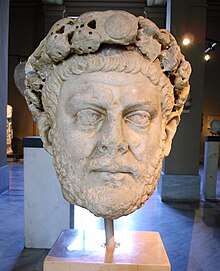A Brief History
On May 1, 305, the Co-Emperors of the Roman Empire, Diocletian and Maximian, teamed up to become the first Roman Emperors to ever resign voluntarily. As incredibly difficult as it is to have two leaders of the same empire, it is all the more remarkable that both would agree to retire on the same day. One of their successors, Constantius I, also known as Constantius Chlorus, served only a year before dying and leaving the throne open to whomever could win the ensuing battles.
Digging Deeper
Diocletian was born in 244 in the Roman Province of Dalmatia, a somewhat larger area than the modern Dalmatia that is part of Croatia today. Having a humble birth into a working class family did not stop Diocletian from finding success in the Roman Army, a venue where performance was valued above birth. He rose to take command of the Roman Cavalry under Emperor Carus, and when Carus and his son were killed in battle in Persia, Diocletian found himself popularly proclaimed as Emperor in 284. As the transfer of power was not usually an easy one when no clear heir stood to inherit a throne, the surviving son of Carus, Carinus, claimed the throne for himself, leading to a battle for Roman leadership. Diocletian prevailed at the Battle of the Margus and consolidated his power as Emperor.

An odd feature of the reign of Diocletian was the appointment of Maximian, a brother in arms as a Roman Army officer, as Co-Emperor in 286. The two emperors more or less split the ruling of the Roman Empire geographically, with Diocletian in the East and Maximian in the West. Administration of the Empire went rather well under the Co-Emperors, and Diocletian took things even further by appointing Galerius and Constantius as “Caesar,” a title of office just under “Augustus” that Diocletian shared with Maximian. The two “Caesars” served under each “Augustus,” with Constantius in the West and Galerius in the East. Each of these “Caesars” would have the right to inherit the throne of their respective half of the Roman Empire. This odd 4 person leadership arrangement was known as the “Tetrarchy.”
Surprisingly, things went rather well during the Tetrarchy, until Diocletian began to tire of his office by 303, and he contracted an illness while waging war in 304. Ill health prompted Diocletian to decide to retire and talk Maximian into doing the same. On May 1, 305, the Emperors retired, Diocletian to his palace in Dalmatia (that still stands today) and Maximian either to Campania or Lucania where he had villas. One stain on the legacy of the Tetrarchy was the severe persecution of Christians in an effort by Diocletian to stamp out Christianity for good. Under Constantine the Great (Constantine II), Christianity became the preferred religion of the Roman Empire.

Unfortunately for Rome, the transition of power did not go as smoothly as planned and intrigue ensued. Succession in Roman thrones, like those in the rest of Europe to follow, was not as simple as passing from heir to heir as otherwise expected. Plots, schemes, fighting, and intrigues often tainted the process of transitioning power. The assumption was that the eldest sons of Diocletian and Maximian, Constantine and Maxentius, would assume the title of Caesar and inherit the thrones, but Severus and Maximinus were appointed Caesar creating a power grab situation. Officially, Constantius Chlorus and Galerius were the successors of the Co-Emperors, but Constantius Chlorus only lived until 306 and Galerius died in 311. When Constantius Chlorus died and left his throne to Constantine II, Galerius was less than enthusiastic. A period of Emperors and Co-Emperors ensued, a convoluted system to say the least! (See our article, “The Death of Commodus Kicks off The Year of the 5 Emperors” about another chaotic period in Roman History.) Certainly, the line of Roman Emperors was long and tortured.
Diocletian died in 312 at the age of 66, a worn out and sick man. Maximian died in 310 at the age of 60.

(Note: A modern example of an Emperor voluntarily abdicating his throne so that his heir could assume the crown occurred on April 30, 2019 (yesterday!) when Japanese Emperor Akihito abdicated in favor of his son, the now Emperor Naruhito. Akihito is now known as Emperor Emeritus.)
Question for students (and subscribers): What other famous abdications of power by a reigning monarch can you name? Do you believe in inherited thrones? Please let us know in the comments section below this article.

If you liked this article and would like to receive notification of new articles, please feel welcome to subscribe to History and Headlines by liking us on Facebook and becoming one of our patrons!
Your readership is much appreciated!
Historical Evidence
For more information, please see…
Gibbon, Edward. The Decline and Fall of the Roman Empire: Volumes 1-3 of 6. Everyman’s Library, 1993.
Strauss, Barry. Ten Caesars: Roman Emperors from Augustus to Constantine. Simon & Schuster, 2019.
The featured image in this article, a historic map by Coppermine Photo Gallery of the Roman Empire during the first tetrarchy, is licensed under the Creative Commons Attribution-Share Alike 3.0 Unported license.


